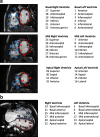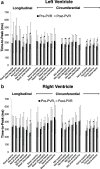Impact of surgical pulmonary valve replacement on ventricular strain and synchrony in patients with repaired tetralogy of Fallot: a cardiovascular magnetic resonance feature tracking study
- PMID: 29909772
- PMCID: PMC6004693
- DOI: 10.1186/s12968-018-0460-0
Impact of surgical pulmonary valve replacement on ventricular strain and synchrony in patients with repaired tetralogy of Fallot: a cardiovascular magnetic resonance feature tracking study
Abstract
Background: In patients with repaired tetralogy of Fallot (TOF), a better understanding of the impact of surgical pulmonary valve replacement (PVR) on ventricular mechanics may lead to improved indications and outcomes. Therefore, we used cardiovascular magnetic resonance (CMR) feature tracking analysis to quantify ventricular strain and synchrony in repaired TOF patients before and after PVR.
Methods: Thirty-six repaired TOF patients (median age 22.4 years) prospectively underwent CMR a mean of 4.5 ± 3.8 months before PVR surgery and 7.3 ± 2.1 months after PVR surgery. Feature tracking analysis on cine steady-state free precession images was used to measure right ventricular (RV) and left ventricular (LV) circumferential strain from short-axis views at basal, mid-ventricular, and apical levels; and longitudinal strain from 4-chamber views. Intraventricular synchrony was quantified using the maximum difference in time-to-peak strain, the standard deviation of the time-to-peak, and cross correlation delay (CCD) metrics; interventricular synchrony was assessed using the CCD metric.
Results: Following PVR, RV end-diastolic volume, end-systolic volume, and ejection fraction declined, and LV end-diastolic volume and end-systolic volume both increased with no significant change in the LV ejection fraction. LV global basal and apical circumferential strains, and basal synchrony improved. RV global circumferential and longitudinal strains were unchanged, and there was a varied impact on synchrony across the locations. Interventricular synchrony worsened at the midventricular level but was unchanged at the base and apex, and on 4-chamber views.
Conclusions: Surgical PVR in repaired TOF patients led to improved LV global strain and no change in RV global strain. LV and RV synchrony parameters improved or were unchanged, and interventricular synchrony worsened at the midventricular level.
Keywords: Feature tracking; Myocardial strain; Pulmonary valve replacement; Tetralogy of fallot; Ventricular synchrony.
Conflict of interest statement
Ethics approval and consent to participate
The Boston Children’s Hospital Committee on Clinical Investigation granted permission for this study and waived the requirement for informed consent.
Competing interests
All authors declare that they have no competing interests.
Publisher’s Note
Springer Nature remains neutral with regard to jurisdictional claims in published maps and institutional affiliations.
Figures




Similar articles
-
Impact of surgical pulmonary valve replacement on ventricular mechanics in children with repaired tetralogy of Fallot.Int J Cardiovasc Imaging. 2017 May;33(5):711-720. doi: 10.1007/s10554-016-1046-2. Epub 2016 Dec 22. Int J Cardiovasc Imaging. 2017. PMID: 28005218
-
Multivariable assessment of the right ventricle by echocardiography in patients with repaired tetralogy of Fallot undergoing pulmonary valve replacement: a comparative study with magnetic resonance imaging.Arch Cardiovasc Dis. 2015 Jan;108(1):5-15. doi: 10.1016/j.acvd.2014.07.054. Epub 2014 Nov 12. Arch Cardiovasc Dis. 2015. PMID: 25453716
-
Left and right ventricular dyssynchrony and strains from cardiovascular magnetic resonance feature tracking do not predict deterioration of ventricular function in patients with repaired tetralogy of Fallot.J Cardiovasc Magn Reson. 2016 Aug 22;18(1):49. doi: 10.1186/s12968-016-0268-8. J Cardiovasc Magn Reson. 2016. PMID: 27549809 Free PMC article.
-
Pulmonary valve replacement after operative repair of tetralogy of Fallot: meta-analysis and meta-regression of 3,118 patients from 48 studies.J Am Coll Cardiol. 2013 Dec 10;62(23):2227-43. doi: 10.1016/j.jacc.2013.04.107. Epub 2013 Sep 28. J Am Coll Cardiol. 2013. PMID: 24080109
-
Repaired tetralogy of Fallot: the roles of cardiovascular magnetic resonance in evaluating pathophysiology and for pulmonary valve replacement decision support.J Cardiovasc Magn Reson. 2011 Jan 20;13(1):9. doi: 10.1186/1532-429X-13-9. J Cardiovasc Magn Reson. 2011. PMID: 21251297 Free PMC article. Review.
Cited by
-
Prognostic value of myocardial deformation parameters for outcome prediction in tetralogy of Fallot.J Cardiovasc Magn Reson. 2024 Winter;26(2):101054. doi: 10.1016/j.jocmr.2024.101054. Epub 2024 Jul 1. J Cardiovasc Magn Reson. 2024. PMID: 38960284 Free PMC article.
-
The Prognostic Importance of Right Ventricular Longitudinal Strain in Patients with Cardiomyopathies, Connective Tissue Diseases, Coronary Artery Disease, and Congenital Heart Diseases.Diagnostics (Basel). 2021 May 26;11(6):954. doi: 10.3390/diagnostics11060954. Diagnostics (Basel). 2021. PMID: 34073460 Free PMC article. Review.
-
State-of-the-art myocardial strain by CMR feature tracking: clinical applications and future perspectives.Eur Radiol. 2022 Aug;32(8):5424-5435. doi: 10.1007/s00330-022-08629-2. Epub 2022 Feb 24. Eur Radiol. 2022. PMID: 35201410 Review.
-
Right-ventricular mechanics assessed by cardiovascular magnetic resonance feature tracking in children with hypertrophic cardiomyopathy.PLoS One. 2021 Mar 18;16(3):e0248725. doi: 10.1371/journal.pone.0248725. eCollection 2021. PLoS One. 2021. PMID: 33735278 Free PMC article.
-
Impact of pulmonary valve replacement on left and right ventricular function using strain analysis, in children with repaired tetralogy of Fallot.Egypt Heart J. 2023 Jun 19;75(1):51. doi: 10.1186/s43044-023-00379-w. Egypt Heart J. 2023. PMID: 37335364 Free PMC article.
References
-
- Valente AM, Gauvreau K, Assenza GE, Babu-Narayan SV, Schreier J, Gatzoulis MA, et al. Contemporary predictors of death and sustained ventricular tachycardia in patients with repaired tetralogy of Fallot enrolled in the INDICATOR cohort. Heart. 2014;100(3):247–253. doi: 10.1136/heartjnl-2013-304958. - DOI - PMC - PubMed
Publication types
MeSH terms
LinkOut - more resources
Full Text Sources
Other Literature Sources
Medical
Research Materials
Miscellaneous

